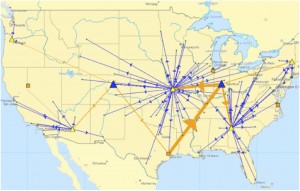 Supply chain optimization is a widespread term, but did you know that an optimized supply chain is not necessarily a resilient one? Seventy-four percent of businesses experienced at least one supply chain disruption in last 12 months, and 38 percent reported a loss in revenue¹. Supply chain resiliency focuses on designing your business and supply chain to quickly bounce back from disruptions. You can use modeling technology to accurately identify and quantify potential supply chain risks and their corresponding costs, and develop mitigation strategies through scenario optimization and advanced analytics to build resiliency into your operations.
Supply chain optimization is a widespread term, but did you know that an optimized supply chain is not necessarily a resilient one? Seventy-four percent of businesses experienced at least one supply chain disruption in last 12 months, and 38 percent reported a loss in revenue¹. Supply chain resiliency focuses on designing your business and supply chain to quickly bounce back from disruptions. You can use modeling technology to accurately identify and quantify potential supply chain risks and their corresponding costs, and develop mitigation strategies through scenario optimization and advanced analytics to build resiliency into your operations.
Understanding the Resiliency of Your Network
Supply chain design technology enables businesses to build digital models of the end-to-end supply chain to evaluate and compare dozens of scenarios side-by-side and test them under real-world variability for better decisions around site selection and product flows. There are four steps businesses can apply to understand and improve the resiliency of their supply chain network:
Assess: Use all modeling and analytics to identify areas of risk. You can use network design models, company KPIs and other metrics to get a holistic look at your supply chain.
Prioritize: Use the information from the assessment to prioritize scenarios to test further with optimization and simulation technology.
Analyze: Use sensitivity analysis and scenarios to test network designs that may increase resiliency. Examples: moving inventory to alternate locations, changing supplier relationships.
Plan: Develop strategies for resiliency-building supply chain changes based on scenario analyses, or develop contingency/response plans for potential disruptive events.
Ways to Evaluate Your Supply Chain Resiliency
Supply chain models put holistic, end-to-end views of the supply chain at the fingertips of supply chain practitioners. Having living digital supply chain models and analytics enables businesses to continuously optimize the end-to-end supply chain, rapidly test new strategies and react to changing market conditions.
Risk Exposure Analysis: Many businesses struggle to collect the data and build reports that can make it easier to identify and assess areas of potential supply chain risk. Visualization tools linked with supply chain models give you quick, aggregated views of the supply chain whenever you need it. This provides high-level metrics for evaluating risk in the supply chain. Summarizing non-cost metrics such as average distance to customer, number of products per facility and single sourced products or components can give insight into the ability of network to recover from a disruption.
Simulate Supply Variability: How long is your whole network down if a critical site is down for an extended period of time? You can use simulation to evaluate actual performance of different network designs over a period of time given these downtimes. This data can be viewed in time-series reports showing missed orders, inventory levels, total cost and more, as a critical way to evaluate resiliency. Evaluating the effect that each site has on the reliability of the entire network can uncover hidden areas of risk in the design.
Multi-Objective Optimization with Risk Data: Integrate supplier scorecard data, facility reliability, days of inventory and other factors into network optimization and build a trade-off curve to visualize the costs and benefits of different options.
Automation of Assessment and Prioritization: New technologies will enable businesses to automate the analysis of a disruption at each of the sites in their supply chain or to simulate numerous network designs’ ability to improve resiliency. Options like these can help companies focus their planning efforts only on the sites that are most critical to the reliability of their operations.
Adopting modeling practices like these can improve your ability to recover from a disruption by identifying areas of potential risk, designing the supply chain to mitigate these risks, and maintaining living models of contingency plans for potential disruptive events.
 Michael Rockett has been a Supply Chain Design Consultant with LLamasoft since May of 2014. Before coming to LLamasoft, Mike received a MBA and a MS in Natural Resources from the University of Michigan and completed multiple supply chain resiliency consulting projects with companies such as Boeing and Keurig Green Mountain.
Michael Rockett has been a Supply Chain Design Consultant with LLamasoft since May of 2014. Before coming to LLamasoft, Mike received a MBA and a MS in Natural Resources from the University of Michigan and completed multiple supply chain resiliency consulting projects with companies such as Boeing and Keurig Green Mountain.
 Aaron Burman is a Senior Supply Chain Design Consultant with LLamasoft. He brings 10 years of corporate sustainability and analytics consulting to his current work. Now he helps companies gain visibility into their complex supply chains and ensure that they are efficient and resilient. He holds a BS in Engineering from the Colorado School of Mines.
Aaron Burman is a Senior Supply Chain Design Consultant with LLamasoft. He brings 10 years of corporate sustainability and analytics consulting to his current work. Now he helps companies gain visibility into their complex supply chains and ensure that they are efficient and resilient. He holds a BS in Engineering from the Colorado School of Mines.
¹ Source: Business Continuity Institute Supply Chain Resilience Report 2015
Using Modeling and Analytics to Design a Resilient Supply Chain
Understanding the Resiliency of Your Network
Supply chain design technology enables businesses to build digital models of the end-to-end supply chain to evaluate and compare dozens of scenarios side-by-side and test them under real-world variability for better decisions around site selection and product flows. There are four steps businesses can apply to understand and improve the resiliency of their supply chain network:
Assess: Use all modeling and analytics to identify areas of risk. You can use network design models, company KPIs and other metrics to get a holistic look at your supply chain.
Prioritize: Use the information from the assessment to prioritize scenarios to test further with optimization and simulation technology.
Analyze: Use sensitivity analysis and scenarios to test network designs that may increase resiliency. Examples: moving inventory to alternate locations, changing supplier relationships.
Plan: Develop strategies for resiliency-building supply chain changes based on scenario analyses, or develop contingency/response plans for potential disruptive events.
Ways to Evaluate Your Supply Chain Resiliency
Supply chain models put holistic, end-to-end views of the supply chain at the fingertips of supply chain practitioners. Having living digital supply chain models and analytics enables businesses to continuously optimize the end-to-end supply chain, rapidly test new strategies and react to changing market conditions.
Risk Exposure Analysis: Many businesses struggle to collect the data and build reports that can make it easier to identify and assess areas of potential supply chain risk. Visualization tools linked with supply chain models give you quick, aggregated views of the supply chain whenever you need it. This provides high-level metrics for evaluating risk in the supply chain. Summarizing non-cost metrics such as average distance to customer, number of products per facility and single sourced products or components can give insight into the ability of network to recover from a disruption.
Simulate Supply Variability: How long is your whole network down if a critical site is down for an extended period of time? You can use simulation to evaluate actual performance of different network designs over a period of time given these downtimes. This data can be viewed in time-series reports showing missed orders, inventory levels, total cost and more, as a critical way to evaluate resiliency. Evaluating the effect that each site has on the reliability of the entire network can uncover hidden areas of risk in the design.
Multi-Objective Optimization with Risk Data: Integrate supplier scorecard data, facility reliability, days of inventory and other factors into network optimization and build a trade-off curve to visualize the costs and benefits of different options.
Automation of Assessment and Prioritization: New technologies will enable businesses to automate the analysis of a disruption at each of the sites in their supply chain or to simulate numerous network designs’ ability to improve resiliency. Options like these can help companies focus their planning efforts only on the sites that are most critical to the reliability of their operations.
Adopting modeling practices like these can improve your ability to recover from a disruption by identifying areas of potential risk, designing the supply chain to mitigate these risks, and maintaining living models of contingency plans for potential disruptive events.
¹ Source: Business Continuity Institute Supply Chain Resilience Report 2015
TAGS
Subscribe to Our YouTube Channel
TOPICS
Categories
Subscribe to Our Podcast
TRENDING POSTS
Sponsors